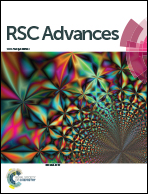Controllable fabrication of metallic photonic crystals for ultra-sensitive SERS and photodetectors†
Abstract
Metallic photonic crystals (MPCs), with extraordinary and controllable optical properties, are extremely desirable for optical sensors, solar energy conversion, ultrasensitive molecular detection and so on. Herein, a series of MPCs with inverse opal structure consisting of plasmonic metals (Ag and Cu) and transition metals (Ni and Co), respectively, are fabricated using a template-assisted electrochemical deposition method. In the UV-vis light region, plasmonic MPCs show tremendously strong multiple plasmon resonance made up of LSPR modes and Bragg modes. These extraordinary optical properties of MPCs are utilized to achieve ultra-sensitive detection (10−13 M, equivalent to ∼0.094 molecules per μm2 on average of the surface area) over a large area (≈1.0 cm2) and a Raman signal enhancement factor of 1.9 × 1010, suggesting that Ag MPCs are capable of single molecule detection. In addition, MPCs can act as efficient light absorbers and catalytically active sites in plasmon-induced direct photocurrent generation. A remarkable rise in photocurrent is observed as the light is switched on for Ag and Cu MPCs, which exhibits a high accordance with a linear model of optical power density.


 Please wait while we load your content...
Please wait while we load your content...